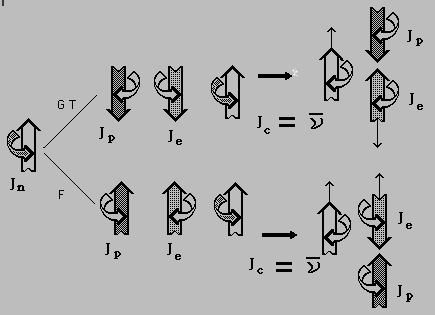|
Let us see how the wave model of deuteron is able teach us the way for interpretating the characteristic model of neutron decay. Neutron has 3 spins. Two of them will always be opposed to each other. The spin of the electron Je will always be antiparallel to the spin of the retrograde variation Jc. Seeing that the orientation of the spin of the proton Jp can do nothing but making the electric effect of proton and electron null, it will be therefore parallel to the electron's spin. Actually, seeing that the proton is within the electron, only when the electron's spin is concordant with the proton's, the secondary anomalies of the waves deriving from proton and electron compensate each other. The result is the annihilation of the opposite charges. It means that the resulting neutron's spin only depends on the spin of the retrograde rotation of the precession inherited by the deuteron. These conditioning rules allow nothing but two types of organization for the relative orientations of the neutron components. The results of experiments on beta decay show in fact the possibility of two different interactions in neutron decay: GT, with the proton's spin antiparallel to the neutron's, and F, with the proton's spin parallel to the neutron's.
Fig.26 The spin mechanics in Beta decay The different interactions GT (Gamov-Teller) and F (Fermi) are the result of two different ways of separating the components, which correspond with the two different possibilities of spin composition, but obey the same laws of behavior influencing both types of decay. In both cases the phenomenon occurs passing from the "bound state" of the neutron to the "observed state" that has an experimental evidence. The passage from the first state to the second one occurs because of the loss of the retrograde rotation condition of wave variation when the electron's resonance orbit returns to its fundamental resonance condition losing the retrograde precession of 120° owing to following decrements. It is difficult to say how the wavefront really behaves in every moment of variation in precession; however, it is useful to know that a phenomenon that in topology is called "catastrophe" occurs during the decrement phase of the angle of precession in its passage from a precession of 240° to a concordant precession inferior to 180°. With little decrements of the angle of precession, which do not cause excessive variations in the state of the system, we suddenly reach a precession of 180°: we switch from the retrograde rotation of the wave variation to a rotation concordant with the rotation of the wavefront. This sudden change is probably the main reason for the beginning of the phenomenon of separation of proton from the electron inglobing it, and the strange entity we have called up to now antineutrino arises this very instant. In this phenomenon the chirality of the wave model plays a decisive role till now unknown. There are two cases:
Besides, an experimental condition, we have not explained yet, exists for the statistic distribution of the electron momenta in beta decay: the so-called continuous spectrum of the electron kinetic energy. With a wave interpretation there is a possibility to explain the cause of the statistically continuous distribution of the electron's momentum in beta decay (for a deterministic research a possibility is better than nothing ). If the rotation of the electron's spin can occur at distances different from the proton for every decay, it is possible for the attractive electric interaction, which varies according to the square of the distance between the two charges, to oppose the chiral impulse given by the antineutrino to the electron, subtracting to it to a more or less great extent, some momenta according to the distance from the proton. The resulting electron momentum could be the result of this subtraction which is statistically and continuously distributed in a great number of beta decays. It seems that there are many divergences between the interpretation we have done till now on beta decay and that here introduced: for example, it seems that there are discrepancies on the interpretation of the correlations of the helicities of the antineutrino in the electron; but it is not true. Everything depends, infact, on the
chirality that has never been taken into account up to now. If we
analyse
Fig.21
we can demonstrate that the helicoid direction of the
electron's wave in the direction of its momentum is exactly equal to
that observed, but never explained, in the experiments on the
correlations of the helicity. |
